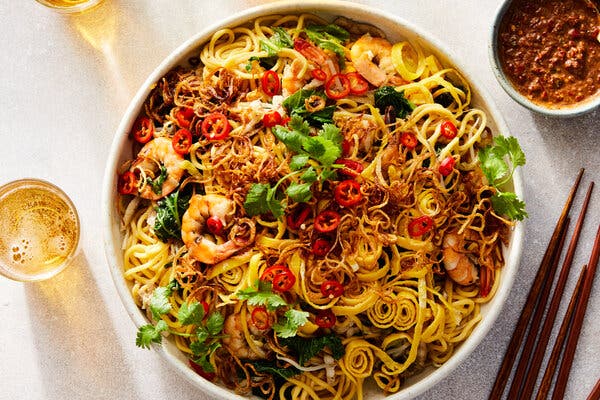Stir-fried noodles, nian gao and more recipes for the holiday.
Good morning. Planning for Lunar New Year, which falls this year on Feb. 1, begins in earnest this week, at least for those who are a) celebrating and b) won’t be doing so in a restaurant. Many will follow family traditions and eat what they usually do on the holiday — longevity noodles; dumplings; lumpia; steamed fish; tang yuan — cooking as much as possible in advance so that there can be a riot of dishes on the table when the moon does its thing, and to prevent chaos in the kitchen.
I’m following the lead of Clarissa Wei, who brought to The Times this week a celebration of a particularly Singaporean Lunar New Year menu. It’s built around the cooking traditions of the Chinese diaspora there — “Hokkien, Cantonese and Teochew from southeastern China,” she writes, and “Hainanese from the island province of Hainan; Hakka, a migrant group spread out all over China; and Peranakan, who have been in the region for over 400 years and also have mixed Malay and European ancestry.”
The shopping may take some time, since I’ll be using the internet and not the local Singaporean market that I wish existed where I’m staying right now. I hope you’ll join me as I cook on the fly.
There’ll be Nonya Hokkien stir-fried noodles (above) tossed in a savory sauce anchored by juicy pork belly and shrimp, and topped with pale yellow egg strips, bright red chiles and vibrant mustard greens. (I’ll need some sambal belacan, a pungent hot sauce of fermented dried shrimp and chiles, to give that dish a bit of heat.)
Also, nasi biryani and chicken curry! Singapore, Clarissa reports or reminds, depending on your experience, is one of the few places where those dishes — with origins on the Indian subcontinent — appear on Lunar New Year tables. I’m in.
Chap chye will be grand as well, braised chopped cabbage, shiitake mushrooms and carrots. Some will add cubes of pork for flavor, or lily buds for texture and, often, a heap of black moss fungus on top because its Cantonese name — fat choy — is a homophone for good luck.
And of course there’s nian gao, sweet rice cake, this version made with baked sweet potato. Nian gao is a homonym for the Chinese phrase “nian nian gao sheng,” which means to rise to greater heights year after year. I hope that’s the case for all of you, whatever you cook.
And for right now? Tonight? You might consider a baked spanakopita pasta with greens and feta, this chickpea and herb fatteh or chicken and rice soup with ginger and turmeric. Alternatively: burgers.
And there’s never a bad time to make BLT tacos. The point is just to get into the kitchen and make something delicious for those in your orbit, using whatever tools you have at your disposal, and to do it with care. They’ll notice, and be grateful. That’s the game right there.
Thousands and thousands more recipes to cook this week are on New York Times Cooking. (Here’s a collection of easy weeknight recipes, should none of the above appeal.) As I point out frequently, you need a subscription to access them, and I thank you for yours. Subscriptions support our work and allow it to continue.
And if something goes sideways while you’re cooking or using our site and app? Please reach out for help: cookingcare@nytimes.com. Someone will get back to you. If not, I’m at foodeditor@nytimes.com. I read every letter sent.
Now, it’s a far cry from basting a pork loin or warming your plates, but I think you should read Thomas Beller, in The New Yorker, on Bill Bradley and his one-man show, “Rolling Along.”
There’s a new Nikky Finney poem in The Bitter Southerner, “Hotbed 11.”
And I liked this Zaz Hollander story in the Anchorage Daily News about how birds in Alaska make it through the winter.
Finally, here’s some new music from Khruangbin and Leon Bridges, “Chocolate Hills.” Spacey and elastic. Listen to that while you cook. I’ll return on Wednesday.


























